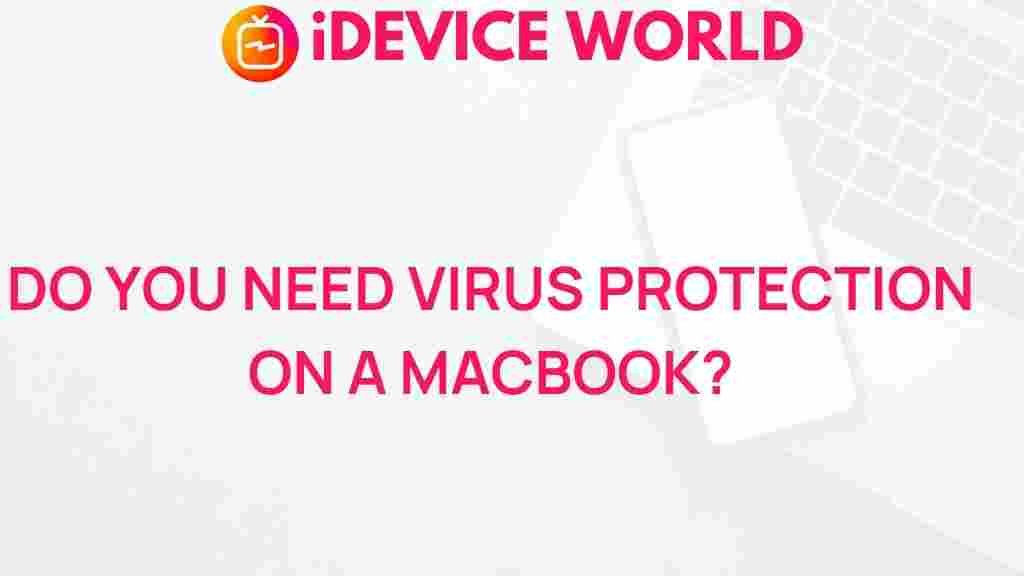Unveiling the Truth: Do MacBooks Need Virus Protection?
In the age of digital technology, MacBooks have gained immense popularity among users for their sleek design, performance, and robust operating system. However, a common question arises: do MacBooks need virus protection? As we delve into this topic, we will explore the security features of MacBooks, the nature of potential threats, and whether additional antivirus software is necessary.
Understanding MacBooks and Their Security Features
MacBooks, powered by macOS, are designed with various built-in security features that help protect users from malware and other security threats. Some of these features include:
- XProtect: This is Apple’s built-in malware detection and removal system. It automatically checks downloaded files against a list of known malware.
- Gatekeeper: Gatekeeper prevents unverified applications from being installed on your Mac. This ensures that only apps from the App Store or identified developers can be run.
- FileVault: FileVault encrypts the entire disk of your MacBook, protecting your data even if the device falls into the wrong hands.
- Sandboxing: Applications on macOS are sandboxed, meaning they run in isolated environments, reducing the risk of one application affecting others.
The Nature of Threats to MacBooks
While MacBooks are relatively secure, they are not invincible. Understanding the types of threats that can affect them is crucial for assessing whether additional protection is necessary. Common threats include:
- Malware: This includes viruses, worms, and trojans that can harm your system or steal your data.
- Phishing Attacks: Cybercriminals often target users through deceptive emails and websites, attempting to steal sensitive information.
- Adware and Spyware: These programs can track your online behavior, compromising your privacy.
- Ransomware: This type of malware encrypts your files and demands a ransom for their release.
Do MacBooks Really Need Additional Virus Protection?
While MacBooks come with built-in security features, many users wonder if they should invest in additional virus protection. The answer depends on several factors:
User Behavior
If you frequently download software from unverified sources, click on suspicious links, or engage in risky online behavior, additional protection may be advisable.
Type of Work
Users who handle sensitive information, such as financial data or personal documents, should consider enhanced security measures.
Frequency of Updates
Regularly updating your macOS and applications is crucial. Apple often releases updates to patch security vulnerabilities. If you keep your system up to date, your MacBook may be less susceptible to attacks.
Step-by-Step Guide: Enhancing Security on Your MacBook
If you decide to implement additional security measures, here’s a step-by-step guide to help you enhance the security of your MacBook:
- Update macOS: Ensure you are running the latest version of macOS. Go to System Preferences > Software Update to check for updates.
- Enable Firewall: Activate the built-in firewall to prevent unauthorized access. Go to System Preferences > Security & Privacy > Firewall.
- Install Antivirus Software: Choose reputable antivirus software that suits your needs. Some popular options include Bitdefender, Intego, and Malwarebytes.
- Use a VPN: A Virtual Private Network (VPN) adds an extra layer of security when browsing the internet, especially on public Wi-Fi networks.
- Practice Safe Browsing: Avoid clicking on suspicious links and only download software from trusted sources.
- Regular Backups: Use Time Machine or a cloud service to back up your data regularly. This ensures you can recover your files in case of a malware attack.
Troubleshooting Common Security Issues
Even with robust security measures, issues may arise. Here are some troubleshooting tips for common security problems:
Identifying Malware
If you suspect that your MacBook may have malware, look for these signs:
- Unexpected pop-ups or ads
- Slow performance
- Unusual network activity
- Unrecognized applications or files
If you notice any of these signs, run a full scan with your antivirus software to detect and remove threats.
Dealing with Phishing Emails
If you receive a suspicious email:
- Do not click on any links or download attachments.
- Check the sender’s email address for authenticity.
- Report the email as phishing in your email client.
- Use a reputable email filter that identifies and blocks phishing attempts.
System Performance Issues
If your MacBook is running slowly, it could be due to malware or simply an overloaded system. Here’s how to troubleshoot:
- Restart your MacBook.
- Check Activity Monitor to identify any resource-hogging applications.
- Clear cache and temporary files to free up space.
Conclusion
In conclusion, while MacBooks have impressive built-in security features, they are not immune to threats. Whether or not to invest in additional virus protection depends on individual user behavior, the type of work performed, and the frequency of system updates. By following best practices for security and staying vigilant against potential threats, you can significantly reduce the risk of malware on your MacBook.
For more information on securing your MacBook, you can check out Apple’s official security guide. Remember, staying informed and proactive is key to keeping your digital life safe.
Additionally, consider exploring other resources on technology and cybersecurity for more tips and strategies to protect your devices and data. For a comprehensive understanding of digital security, visit this link.
This article is in the category Guides & Tutorials and created by iDeciveWorld Team
